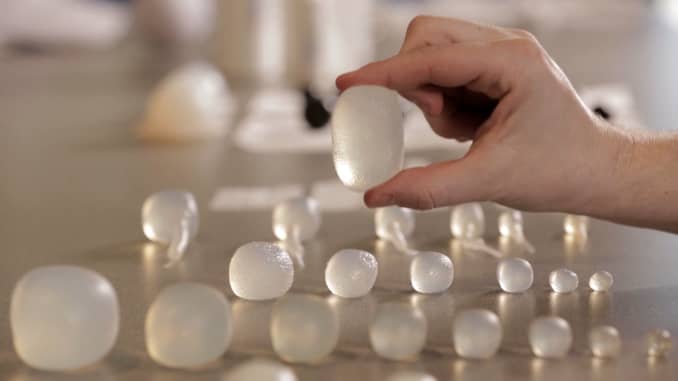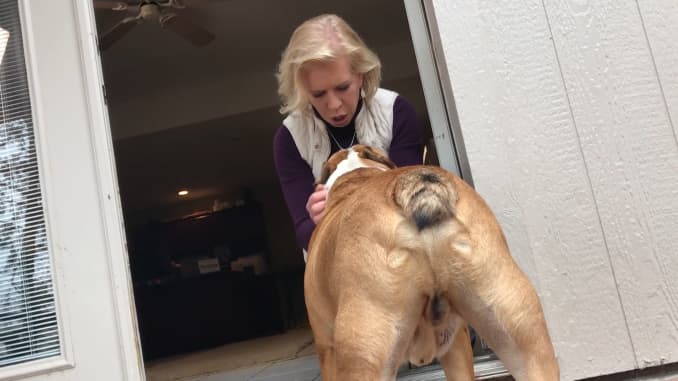Gregg Miller proves you can make a fortune with anything. Even dog balls.
Not the kind you throw around playing in the dog park.
“What I’m doing is I’m developing testicular implants for pets,” Miller tells CNBC.
The 64-year-old inventor and entrepreneur created Neuticles, silicone implants for male dogs to replace testicles after neutering, so that a dog’s appearance…down there…doesn’t change.
It’s made him a millionaire.
Do dogs care about this? “Yes, they do,” Miller says.
Certainly their owners must. Over the last 20 years, Miller claims he’s sold over 500,000 sets of Neuticles. The average pair costs $310, though some cost a lot more, like the $2,800 watermelon-sized custom set Miller made for an elephant in a zoo.

CNBC
The strange path to success
Gregg Miller grew up near Kansas City and studied journalism at Central Missouri State, but he hated the newspaper business, so he started his own advertising company over the objections of his parents. “They didn’t think about being an entrepreneur as a positive thing,” he says.
One day he noticed a catalog came in the mail in a tube. “I thought, ‘God, something more can be done with this little tube than just mailing a catalog.’” He decided to put candy in it.
Miller invented SweeTube, a three-foot long tube filled with layers of candy, which he ended up selling to outlets like Macy’s and Disneyland. A dozen years later, he stopped. “Believe me, after 12 years of the candy business, you get kind of sick of it,” he said. “It gets sticky, the shelf life is bad, people don’t pay their bills. So I thought, ‘What can I do?’”
This was in the mid ’90s, and Miller had recently bought a bloodhound puppy named Buck. He refused to neuter Buck, not wanting to put the dog (or himself) through that experience. But one day Buck went missing, a story which still makes Miller emotional. “It was the most hideous four days of my life,” he says.

Courtesy of Gregg Miller
Buck had apparently taken off after smelling the scent of a female dog in heat. He was eventually found a few miles away. “He saw me, I saw him…and it’s like what you see in the scene when there’s two fat people running across the field to embrace.” Miller realized, though, that he needed to neuter Buck, or “this is going to happen again.’”
That’s when the idea for Neuticles first came into Gregg Miller’s head. He asked his veterinarian if someone made implants, “so Buck can maintain his God-given natural look.” The vet told him that was “the craziest damn thing I’ve ever heard of.”
Miller went ahead and had Buck neutered, though he hated putting the puppy through the surgery. Afterward, Buck went to clean himself. “He loved to do that. The slurping noise that was so freaking obnoxious,” Miller says, mimicking a slurping hound sound. He’s convinced Buck noticed something was missing, and the dog looked back up at his master. “He was telling me, ‘They’re gone. What happened?’”
Not long after this, Miller says the veterinarian changed his mind about a testicular implant being “crazy,” and the two of them started to develop a prototype.
Success…and failure…and success
Miller says he and a group of 32 local investors spent over $100,000 to develop Neuticles. “I maxed out my credit cards and then maxed out the mortgage on my home.”
The veterinarian tested the first prototypes on 30 different pets without any problems, and the first commercially implanted Neuticles went into a dog in 1995. “My parents, who were alive back then, thought I was absolutely crazy,” Miller says. “Everybody that I knew thought that was the sickest thing you could possible think of. Printers would not even print my material.”
Still, there was a lot of media attention. It soon wore off, and Miller was bleeding cash. “For the first five years, I didn’t know whether we would make it,” he says. He was down to a single working light bulb at one point. “Whenever I went from room to room, I had to take my light bulb with me to put into a light socket.”
Miller began advertising in dog magazines. He did radio interviews around the country and offered free Neuticles to listeners. He built up a network of veterinarians, and business finally boomed. “I was getting literally anywhere between 250 and 500 responses a day,” he says.
The clunking problem
There was a problem, however. The original Neuticles were made of a hard plastic-like material. Customers complained their dogs made a “clunking” sound when they walked or sat down. “That was an issue that we endured for three years until some genius, God bless him wherever he was, invented solid silicone,” Miller says.
The most popular Neuticles are now made of solid silicone which is textured to prevent scar tissue from forming, and they cost as much as $469 a pair. “It’s incredibly gushy-soft.”
Miller says celebrity clients include the Kardashians, who bought a pair a few years ago for their dog Rocky. “They had ordered the cheapest ones possible,” Miller laughed, “the hard ones, the clackers, and I thought, ‘Wow.’”
Of course, not everyone is a fan. Miller said that even though there has never been a complication from Neuticles over the last quarter century, “We have a lot of haters.” His reaction? “Mind your own damn business.”
The product has even been banned in a few countries, a fact Miller is proud of, but he doesn’t let such details stop him from meeting demand from customers in those far-off lands. To get the product through customs, he just rebrands it. “What I do is I call it a stress ball.”
The house that Neuticles built
Neuticles come in 11 different sizes to fit a variety of pets, and Miller has expanded his product line to include eye implants for animals, including horses, along with stays for holding up cropped ears and allergy products for sensitive pet skin. He even turned some Neuticles into pendant earrings and necklaces, and he’s written a book called, “Going…Going…Nuts.”

CNBC
As successful as he’s been, Miller has no intention of making implants for humans. It costs too much and takes too long to gain FDA approval, while implants for pets require no approval at all.
Indeed, fake dog balls has turned out to be his most lucrative endeavor. Miller calls his home outside Independence, Missouri, “The House that Neuticles Built.” It comes complete with a man cave housing a walk-in humidor for his expensive cigar collection, working slot machines from Las Vegas, and a sauna where Miller sweats away his stress after a day of work — “You’ve got fluids coming out of you that you never knew existed from every part of your body.”
Sometimes Miller drives his new Mercedes down the highway to one of the six billboards advertising Neuticles he put up along I-70. “When I’m driving my brand new car, and I pass the billboard, I get this rush that is indescribable,” he says. “I mean, it’s a feeling of ‘Wow.’”
Buck the bloodhound died several years back, but Gregg Miller enjoys life these days with a bulldog named Humphrey, who has also been neutered and implanted with Neuticles. As much as Miller believes neutered dogs miss their, you know, parts, “Let’s face it, the pet owner is the one who writes the check, so it’s more for the pet owner.”

CNBC
He believes his invention has actually encouraged some pet owners to neuter their dogs. “Their dogs don’t have to be turned into eunuchs anymore, and, to me, that’s priceless.”